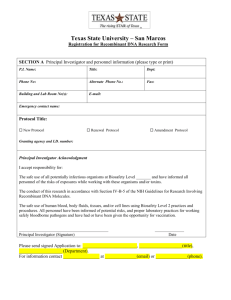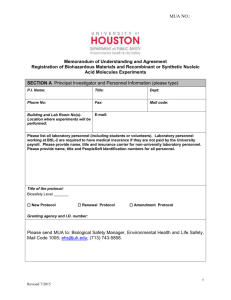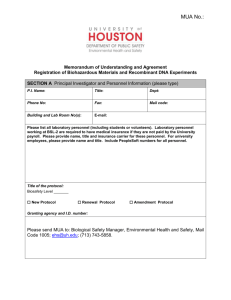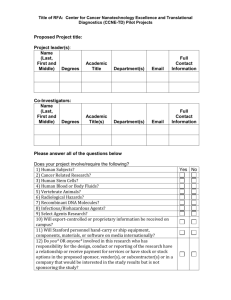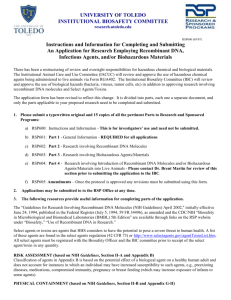BiosafetyMUA
advertisement
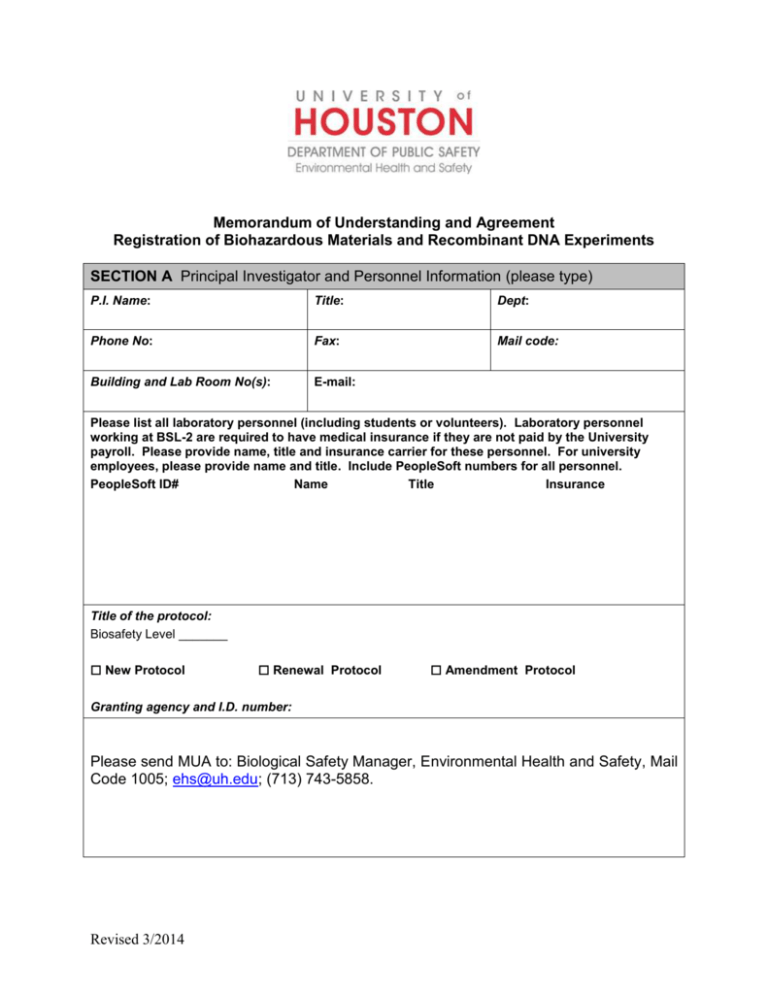
Memorandum of Understanding and Agreement Registration of Biohazardous Materials and Recombinant DNA Experiments SECTION A Principal Investigator and Personnel Information (please type) P.I. Name: Title: Dept: Phone No: Fax: Mail code: Building and Lab Room No(s): E-mail: Please list all laboratory personnel (including students or volunteers). Laboratory personnel working at BSL-2 are required to have medical insurance if they are not paid by the University payroll. Please provide name, title and insurance carrier for these personnel. For university employees, please provide name and title. Include PeopleSoft numbers for all personnel. PeopleSoft ID# Name Title Insurance Title of the protocol: Biosafety Level _______ New Protocol Renewal Protocol Amendment Protocol Granting agency and I.D. number: Please send MUA to: Biological Safety Manager, Environmental Health and Safety, Mail Code 1005; ehs@uh.edu; (713) 743-5858. Revised 3/2014 Memorandum of Understanding and Agreement Registration of Biohazardous Materials and Recombinant DNA Experiments For purposes of this registration, biohazardous materials are defined as any organism known to or suspected of causing infection in humans, and a toxin is a proteinaceous poison which is highly toxic to humans. Experiments using biohazardous materials and toxins must follow the CDC/NIH Biosafety in Microbiological and Biomedical Laboratories (BMBL) Guidelines (5th Edition-2009).Experiments using recombinant DNA technology must follow the NIH Guidelines for Research Involving Recombinant or Synthetic Nucleic Acid Molecules (March 2013). The Principal Investigator (PI) is responsible for completing the appropriate parts of this registration document. The UH Institutional Biosafety Committee (IBC), in conjunction with the Environmental Health and Safety (EHS), maintains a registry of all laboratories and personnel working with human pathogens, and/or toxins, human blood, body fluids, and tissues, and recombinant DNA technology. The PI is also responsible for notifying EHS when work with any potentially infectious material is terminated or when other significant changes occur, such as changes in protocol, personnel or relocation of the laboratory. This document is to be forwarded to EHS (Biological Safety Manager) for approval by the IBC prior to the initiation of work. This document must be made available to all laboratory personnel to ensure proper laboratory practices are followed. Each individual listed should be informed of the potential hazards associated with this work, the appropriate safety practices to be used, the availability of medical programs, and applicable training requirements. Laboratory personnel handling human samples (including cell/tissue culture) must have a completed Hepatitis B Vaccination form on file with Environmental Health and Safety. EHS conducts an annual survey of registered laboratories to review practices and procedures. The survey is not intended to negate the responsibilities of the PI in supervising work with potentially infectious or hazardous materials. RISK GROUPS AND BIOSAFETY LEVELS should be determined using the BMBL and the NIH Recombinant or Synthetic Nucleic Acid Guidelines. Additional information for infectious agents can be found on the American Biological Safety Association (ABSA) website (http://www.absa.org/riskgroups/index.html) Revised 3/2014 SECTION B Brief description of the research understandable to scientist working in different fields New Protocol Renewal Protocol Amendment Protocol Title of the protocol: ___________________________________________________________ This project will use: Biohazardous Material Biological Toxins Recombinant DNA B.1. General description of research (Please give a lay summary): B.2. Describe experimental design: 1.) Describe the hypothesis 2.) Describe the general summary of experimental protocol 3.) Describe where safety exposure risks could occur 4.) Explain the manipulation of experimental/biological material in this protocol as is relevant to safety (consider toxins and/ or biological agents) B.3. Type of manipulations of samples: Centrifugation Dissection Other ___________________ Filtration Mixing Pipetting Section C Use of recombinant DNA technology (including siRNA) Precipitation Sonication Not Applicable Will studies include expression of genes or gene products, other than those used for selection purposes (ex. Ampicillin resistance)? No Yes what protein _____________________________ Prokaryotic Hosts/ Eukaryotic Cells List Strains Vector DNA Insert If a viral vector is used, will infectious virus be generated? Revised 3/2014 Relevant section of NIH Guidelines No Biosafety Containment Level Yes Is viral vector replication defective? No Yes Please provide verification:___________________________ Section D Non-pathogens, pathogens and/or toxins (please provide information for each microorganism and or toxin used, use additional space if needed) Not Applicable Pathogenic Organism: Strain: Volume used: Risk Group: Non-pathogenic Organism: Strain: Volume used: Risk Group: Volume used: Risk group: Biological Toxins: Section E Use of Animals Are animals used in this project? No Yes Will animals be bred for this project? No Yes If yes, please provide IACUC Approval number and date _____________ List all animals used in the project Organism, toxin, or rDNA introduced Routes of administration Types of animal tissue handled and/or animal cell lines: Section F Handling of Human Products (requires BSL-2 practices) Are Human samples used in this project? No Yes If yes, please provide IRB Approval number and date _______________ Have the human samples used in this project been screened for bloodborne pathogens? No Yes Have laboratory personnel received or been offered the Hepatitis B Vaccination? No Yes Type of human samples manipulated: Cell lines Blood Tissues Other ___________________ Revised 3/2014 Urine Spinal Fluid Serum Feces Semen Specify____________________________________________ What volume will be maintained at any given time:_______________________________________ How long will the samples be maintained: ______________________________________________ Section G Safety, Security, and Training Plan - Use the BMBL as a guide only to write your specific safety procedures. Follow the outline below for the items that are applicable to your project (please put N/A for the items that do not apply to your laboratory). If you are working with animals, describe in detail the safety protocol for handling infected animals in the Animal Care Facility. G.1. Training Plan: General Laboratory Safety and Hazardous Materials Orientation Biosafety Training with Bloodborne Pathogens Bloodborne Pathogens Annual Refresher Training Infectious Substance Shipping/Transport Training Fit Testing (for respirator users) Other ___________________ Briefly Describe Laboratory Specific Training: G.2. Security Plan (include access to both laboratory and biological agents): G.3. Specific Laboratory Practices: G.4. Personal Protective Equipment (PPE) Required: Lab coat Gloves Goggles Safety glasses Respirator (specify) ___________________ Face mask Other ___________________ Closed-toe shoes Long pants G.5. Containment Equipment: Is containment equipment available in the laboratory? No Yes Containment equipment used for this project: Biological Safety Cabinet: Last Certified:__________ Fume Hood Containment Centrifuge Other ___________________________ Will vacuum lines be used in this project? No Yes In-line filter present on vacuum line No Yes G.6. Decontamination Procedures: G.7. Spill Clean Up Procedures: G.8. Transfer and/or Transport of Biohazards Between/Outside the Laboratories: G.9. Handling of Hazardous Waste: G.10. Medical Surveillance: Will ship biohazardous material Revised 3/2014 No Yes Will generate biohazardous waste No Yes The following websites contain information that can help you complete the MUA CDC - Biosafety in Microbiological and Biomedical Laboratories (BMBL) http://www.cdc.gov/OD/ohs/biosfty/bmbl5/bmbl5toc.htm NIH guidelines for work with recombinant or synthetic nucleic acid molecules http://oba.od.nih.gov/oba/rac/Guidelines/NIH_Guidelines.htm ABSA - American Biological Safety Association Risk Group classification tables http://www.absa.org/riskgroups/index.html WHO 2004 Laboratory Biosafety Manual http://www.who.int/csr/resources/publications/biosafety/en/Biosafety7.pdf Revised 3/2014
